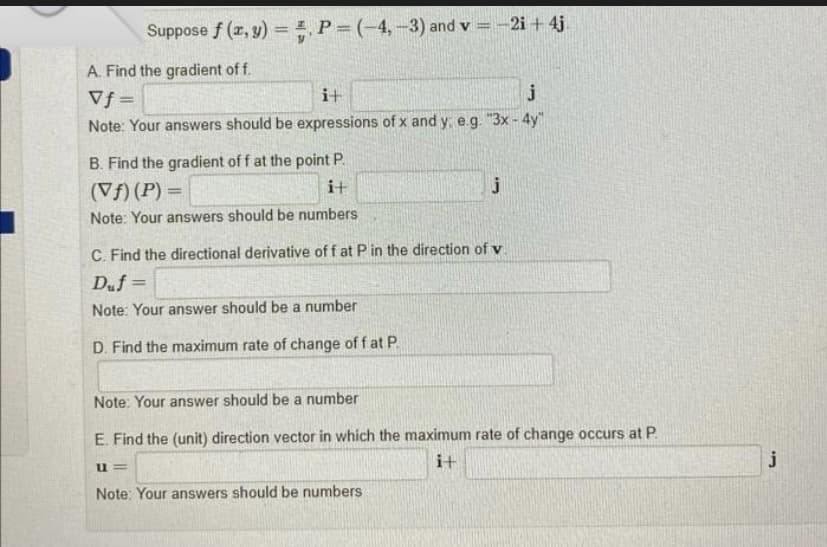Suppose f (z, y) = , P= (-4,-3) and v =-2i + 4j %3D %3D A. Find the gradient of f. Vf = i+ j Note: Your answers should be expressions of x and y, e.g. "3x - 4y" B. Find the gradient of f at the point P. (Vf) (P) = i+ j %3D Note: Your answers should be numbers C. Find the directional derivative of f at P in the direction of v D.f = Note: Your answer should be a number
Suppose f (z, y) = , P= (-4,-3) and v =-2i + 4j %3D %3D A. Find the gradient of f. Vf = i+ j Note: Your answers should be expressions of x and y, e.g. "3x - 4y" B. Find the gradient of f at the point P. (Vf) (P) = i+ j %3D Note: Your answers should be numbers C. Find the directional derivative of f at P in the direction of v D.f = Note: Your answer should be a number
Algebra & Trigonometry with Analytic Geometry
13th Edition
ISBN:9781133382119
Author:Swokowski
Publisher:Swokowski
Chapter3: Functions And Graphs
Section3.3: Lines
Problem 21E
Related questions
Question

Transcribed Image Text:Suppose f (z, y) = , P = (-4,-3) and v =-2i + 4j.
A. Find the gradient of f.
i+
j
Vf =
Note: Your answers should be expressions of x and y e.g. "3x - 4y"
B. Find the gradient of f at the point P.
(Vf) (P) =
i+
Note: Your answers should be numbers
C. Find the directional derivative of f at P in the direction of v
Duf =
Note: Your answer should be a number
D. Find the maximum rate of change of f at P.
Note: Your answer should be a number
E. Find the (unit) direction vector in which the maximum rate of change occurs at P.
i+
j
u=
Note: Your answers should be numbers
Expert Solution
This question has been solved!
Explore an expertly crafted, step-by-step solution for a thorough understanding of key concepts.
This is a popular solution!
Trending now
This is a popular solution!
Step by step
Solved in 2 steps with 3 images

Recommended textbooks for you

Algebra & Trigonometry with Analytic Geometry
Algebra
ISBN:
9781133382119
Author:
Swokowski
Publisher:
Cengage

College Algebra (MindTap Course List)
Algebra
ISBN:
9781305652231
Author:
R. David Gustafson, Jeff Hughes
Publisher:
Cengage Learning

Algebra & Trigonometry with Analytic Geometry
Algebra
ISBN:
9781133382119
Author:
Swokowski
Publisher:
Cengage

College Algebra (MindTap Course List)
Algebra
ISBN:
9781305652231
Author:
R. David Gustafson, Jeff Hughes
Publisher:
Cengage Learning